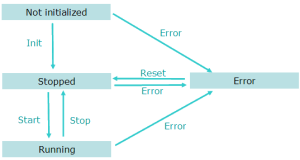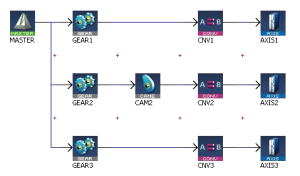Initialize and Start a Pipe Network
The Motion State Machine![]() The complete assembly of all connected parts or devices, of which at least one is movable. is driven by the IEC
The complete assembly of all connected parts or devices, of which at least one is movable. is driven by the IEC![]() International Electrotechnical Commission - A not-for-profit, non-governmental international standards organization that prepares and publishes International Standards for all electrical, electronic and related technologies. 61131-3 application with the help of dedicated function blocks
International Electrotechnical Commission - A not-for-profit, non-governmental international standards organization that prepares and publishes International Standards for all electrical, electronic and related technologies. 61131-3 application with the help of dedicated function blocks![]() A function block groups an algorithm and a set of private data.
It has inputs and outputs..
A function block groups an algorithm and a set of private data.
It has inputs and outputs..
Figure 1: Motion State Machine
Each arrow represents a transition from one State to another one.
To start a Pipe Network in an IEC 61131-3 application program![]() The act of performing a sequence of instructions or commands., these steps must be performed with their respective functions
The act of performing a sequence of instructions or commands., these steps must be performed with their respective functions![]() A function calculates a result according to the current value of its inputs.
A function has no internal data and is not linked to declared instances.:
A function calculates a result according to the current value of its inputs.
A function has no internal data and is not linked to declared instances.:
|
Step |
ML Function Block |
Description |
|---|---|---|
|
||
|
Profiles |
Create Cam Profiles from cam files. |
|
|
3. Create Pipe Network |
Pipe Network |
|
|
||
|
5. Power on all axes |
Pipe Network |
|
|
6. Activate the pipes |
Pipe Network |
|
|
7. Connect the axes to the pipes |
Pipe Network |
Example: In this Pipe Network, the function connects the Converter blocks (CNV1, CNV2 and CNV3) to the Axis blocks: |
See click here... for more information about all ML function blocks related to motion








